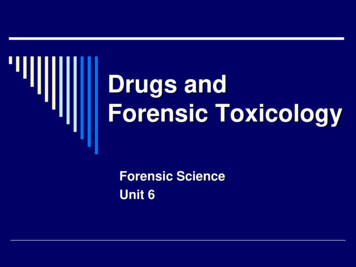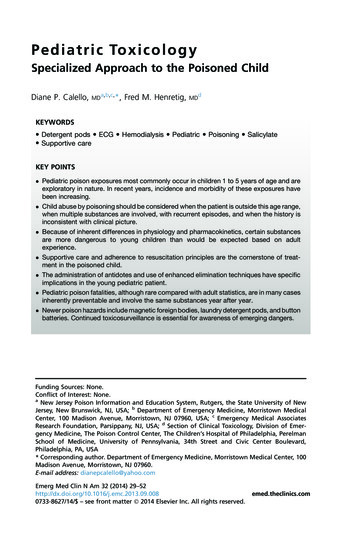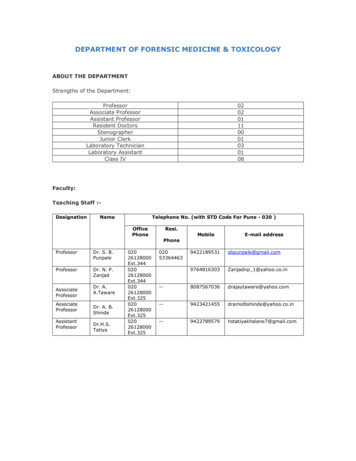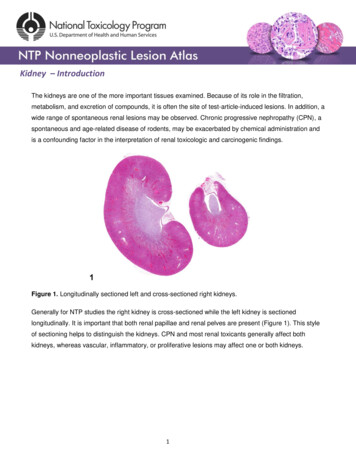
Transcription
SURFACTANT TOXICOLOGYToxicology, Europe/Africa0209.0/(-:
SURFACTANT TOXICOLOGYOutline Toxicity related to surfactant action Specific cases of toxicity– Genotoxicity– Oestrogenicity
SURFACTANT TOXICOLOGYToxicity related to surfactant actionSkin Corrosion (tissue destruction) Irritation (inflammation) Sensitisation (allergy) Irritative dermatitisEyes Corrosion (tissue destruction) Irreversible corneal lesions (blindness) Irritation (inflammation eye lids)Intestines Necrosis Inflammation Water retention o hypovolemic shockKinetics Poor skin absorption Poor intestinal absorption Enhancement of skin absorption of otherchemicals
SURFACTANT TOXICOLOGYToxicity related to surfactant actionCommon toxicologic mechanism:Disturbance of cell membrane integrity
SURFACTANT TOXICOLOGYToxicity related to surfactant action
SURFACTANT TOXICOLOGYToxicity related to surfactant action
SURFACTANT TOXICOLOGYPoly-ethoxylated fatty aminesNNOHNONOOHONNOHOOOOHONOHOOONOOHOOOH
SURFACTANT TOXICOLOGYSphingolipids of the cell omyelinOHOOPOHON
SURFACTANT TOXICOLOGYToxicity related to surfactant actionNNcell membrane ororganelle membranes
SURFACTANT TOXICOLOGYAggresivity to mucous membranes/skinNVery corrosiveFatty aminesNCorrosiveNIrritantNAlkalinityWater solubilityHumectant
SURFACTANT TOXICOLOGYAggresivity to mucous membranes/skinCorrosive and antisepticN Quaternary ammonium saltsN N HumectantN AlkalinityWater solubility
SURFACTANT TOXICOLOGYToxicityPNeurotoxicPhosphate estersPPPWater solubilityHumectant
SURFACTANT TOXICOLOGYSurfact.TypeHOE T3329MON0818Dodigen4022Tween20G3 mixNNCytotoxicity(EC50,ug/mL)Eyeirritation(EU class)Fishtoxicity(LC50,mg/L)28Xi, R410.1-126Xi, R411.3233 Xi 50069502162068 Xi500-1000N ODodigen 4022 Tween 20
SURFACTANT TOXICOLOGYToxicity related to surfactant actionHealth hazardEfficacyCorrosionIrritationOptimumefficacyNo irritationDilution
SURFACTANT TOXICOLOGYSpecific toxicity cases: DNA adductsPeluso et al., 1998:Increase of DNA adducts in liver and kidneys of miceafter intraperitoneal injection (I.p.) of Italian Roundup(MON 35050, not anymore commercial) dissolved inDMSO/olive oilThis in-vivo genotoxicity finding was cause of concernto regulatory authorities
SURFACTANT TOXICOLOGYSpecific toxicity cases: DNA adductsTo better understand the significance of thesefindings Monsanto undertook research toexamine the role of: The route of administration (I.p. vs oral) The vehicle (DMSO/olive oil vs saline) The surfactant (MON 35050 with and withoutglyphosate)
SURFACTANT TOXICOLOGYSpecific toxicity cases: DNA adductsLiver toxicity in the CD-1 mouse:influence of surfactant and vehicle after I.P. administrationLiver enzyme activity200015001000DMSO/OO 35050 - glyDMSO/OO 35050Saline 35050DMSO/OO5000ALTASTLDHBUNSDH
SURFACTANT TOXICOLOGYSpecific toxicity cases: DNA adductsLiver toxicity in the CD-1 mouse:influence of route of administrationLiver enzyme H
SURFACTANT TOXICOLOGYSpecific toxicity cases: DNA adductsMechanismPeritoneal cavityWhite precipitations with surfactantSurfactant penetratesperitoneum and livercapsuleLocal toxicity withoxidative damagePeritoneumLiverLiver capsule
SURFACTANT TOXICOLOGYSpecific toxicity cases: DNA adductsConclusions of MON 35050 case The I.P. route is an inappropriate route of administration The vehicle (DMSO/olive oil) produces precipitates ontothe peritoneal membrane with very high localconcentrations of surfactant as a consequence oinflammation in underlying organs! The surfactant (alkyl sulphate) is the cause of theoxidative damage of DNA in liver and kidneys and notglyphosate The observation of the EU/BBA on the Peluso et al. paperwas: “ some indications of DNA damage have beenobserved rather due to cytotoxic properties of theformulation ”
SURFACTANT TOXICOLOGYSpecific toxicity cases: n through biodegradation indischarge water treatment stationsHO
SURFACTANT TOXICOLOGYSpecific toxicity cases: Oestrogenicity17E-oestradiol4-nonyl phenolOHHOHOOestrogen receptor
SURFACTANT TOXICOLOGYSpecific toxicity cases: OestrogenicityVitellogenin production in troutFeminisation of male troutERE
SURFACTANT TOXICOLOGYSpecific toxicity cases: OestrogenicityIn-vitroIn-vivoRecept. Prolifer. nBBPERERERPeripubertalDBPERERERSem. Ves.Penis (F1)NPERERERVaginalopeningBPAERERERPeripubertal
SURFACTANT TOXICOLOGYSpecific toxicity cases: OestrogenicityConclusions of the case the polyethoxylated nonylphenol surfactants (1) Polyethoxylated nonyl phenol (and octyl phenol, decylphenol, undeceyl phenol, dodecyl phenol) surfactantsbiodegrade to form oestrogenic chemicals (mimic femalehormones). Nonyl phenol has been shown to be oestrogenic inmammals in-vitro and in-vivo, however, the potency isapprox 1,000-10,000 times lower than that of naturaloestradiol. Nonyl phenol has been shown in-vitro, in vivo and in thefield that it can feminise fish at environmentally relevantconcentrations
SURFACTANT TOXICOLOGYSpecific toxicity cases: OestrogenicityConclusions of the case the polyethoxylated nonylphenol surfactants (2) An effort will have to be done by the pesticide industryto avoid using these surfactants in new formulations andwhenever practically possible to replace them in existingformulations Monsanto Europe successfully undertook research tofind a suitable replacement for polyethoxylated nonylphenols. The new surfactant mix has similar technicalproperties and does not biodegrade into oestrogenicmolecular species. It has already been proposed toreplace surfactants in triallate formulations.
SURFACTANT TOXICOLOGYGeneral conclusions Surfactants are biologically not “inert”, they can be toxicand this must be addressed Part of the toxicity of surfactants is related to the surfactantaction which destabilises cell membranes Part of the toxicity of surfactants can be specific (skinsensitisation, oestrogenicity) The toxicity of surfactants depends of their concentrationin the formulation The high added value of herbicide formulations containingsurfactants resides in the optimal compromise betweenefficacy and safety for man and the environment
ALT AST LDH BUN SDH DMSO/OO DMSO/OO 35050 DMSO/OO 35050 - gly Saline 35050 . White precipitations with surfactant Peritoneum Liver capsule Local toxicity with . The observation of the EU/BBA on the Peluso et al. paper was: " some indications of DNA damage have been observed rather due to cytotoxic properties of the .










